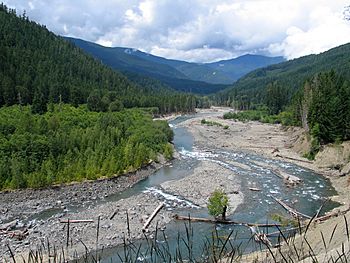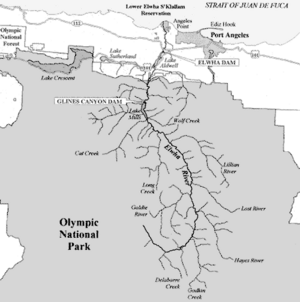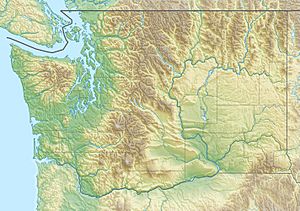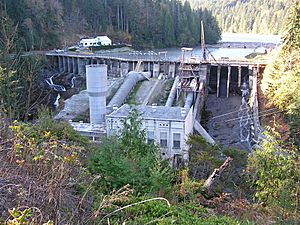Elwha River facts for kids
The Elwha River is a 45-mile (72 km) long river located on the Olympic Peninsula in Washington, a state in the United States. It starts high up in the Olympic Mountains and flows generally north until it reaches the Strait of Juan de Fuca. Most of the river runs through the beautiful Olympic National Park.
The Elwha River is special because it's home to all five types of native Pacific salmon: chinook, coho, chum, sockeye, and pink salmon. It also has four kinds of migratory trout, like steelhead and bull trout. For over 100 years, from 1911 to 2014, two large dams blocked the river. These dams stopped fish from swimming upstream to lay their eggs. Before the dams, about 400,000 adult salmon returned to the river each year. With the dams, fewer than 4,000 salmon could return.
The National Park Service led a huge effort called the Elwha Ecosystem Restoration Project. This project removed both dams to help the river and its fish recover. The dam removal started in September 2011 and finished in August 2014. Since then, the river has carried lots of sand and dirt to its mouth, creating new areas for plants and animals to live.
The name Elwha River first appeared on a map made by Henry Kellett in 1846.
Quick facts for kids Elwha River |
|
|---|---|

Elwha River
|
|

Map of the Elwha River
|
|
|
Mouth of the Elwha River in Washington
|
|
| Country | United States |
| State | Washington |
| Counties | Clallam, Jefferson |
| City | Port Angeles |
| Physical characteristics | |
| Main source | Olympic Range 3,655 ft (1,114 m) 47°46′8″N 123°34′43″W / 47.76889°N 123.57861°W |
| River mouth | Strait of Juan de Fuca 0 ft (0 m) 48°9′2″N 123°33′35″W / 48.15056°N 123.55972°W |
| Length | 45 mi (72 km) |
| Basin features | |
| Basin size | 318 sq mi (820 km2) |
| Tributaries |
|
Contents
Where Does the Elwha River Flow?
The Elwha River starts high up in the Olympic Mountains in Jefferson County, Washington. Its source is near the Elwha snowfinger, close to Mount Barnes and Mount Queets. The river first flows southeast, then turns north for most of its journey. It finally empties into the Strait of Juan de Fuca.
Many tall mountains are near where the Elwha begins, such as Mount Christie and Mount Carrie. As the river flows, it picks up water from smaller streams like Delabarre and Godkin creeks. The Hayes River and Lost River also join the Elwha in a place called Press Valley. After this, the Elwha River crosses into Clallam County, Washington.
The Grand Canyon of the Elwha
After entering Clallam County, the Elwha River flows through a deep and narrow area known as the Grand Canyon of the Elwha. A bridge called Dodger Point Bridge crosses the river as it leaves this canyon. Further downstream, you can find the Humes Ranch Cabin near the river.
Before the dams were removed, the river used to spread out into a wide area at the start of Lake Mills. This lake was formed by the Glines Canyon Dam. Below where the Glines Canyon Dam used to be, the river flows past the Olympic Hot Springs Road and receives water from Madison Creek. You can also find Madison Creek Falls nearby. Campgrounds and the Elwha Ranger Station are located along the river before it leaves Olympic National Park.
Journey to the Sea
Further downriver, past where the Elwha Dam used to stand, the Elwha River flows north through the Elwha Canyon. It then passes through the Lower Elwha Indian Reservation. Finally, the river reaches the Strait of Juan de Fuca at Angeles Point, which is just west of the city of Port Angeles, Washington.
Why Were the Elwha Dams Removed?
The Elwha River is famous for having the largest dam removal project in history! This project, called the Elwha Ecosystem Restoration, aimed to bring the river's natural environment back to life. It was the second-biggest restoration project ever attempted by the National Park Service.
In 1992, a law called the Elwha River Ecosystem and Fisheries Restoration Act was passed. This law allowed the government to buy and remove the two dams on the river. The main goal was to restore the river's ecosystem and help the native fish, especially the salmon, return to their old spawning grounds.
Removing the Dams
The two dams were the 108-foot (33 m) tall Elwha Dam and the 210-foot (64 m) tall Glines Canyon Dam. Their removal began in September 2011. Before the dams were taken down, two water treatment plants were built. These plants protected the drinking water for Port Angeles and the fish hatcheries from the mud and dirt that would wash downstream once the dams were gone.
To protect the fish living below the dams, the removal process was done slowly over three years. This allowed time for the river to clear up between stages, so salmon could still lay their eggs without too much silt.
The Elwha Dam was completely taken apart by March 2012. After it was gone, thousands of native plants were planted in the area to help the land recover. The Glines Canyon Dam was fully removed in August 2014.
A River Reborn
Now that the dams are gone, salmon can naturally swim up and down the 70 miles (110 km) of river habitat inside Olympic National Park. The areas that were once covered by the dam reservoirs are being replanted to prevent soil from washing away and to help the environment heal faster.
Because almost all of the Elwha's watershed is in a national park, the river should become very clean and healthy. It won't have many of the problems that affect other salmon rivers, like pollution from farms or water getting too warm. Experts believe that up to 392,000 fish could eventually fill the 70 miles of habitat, possibly reaching the numbers seen before the dams were built.
By late 2012, about 10 percent of the huge amount of sediment (dirt and sand) that had been trapped behind the dams had moved to the mouth of the Elwha. Heavy rains helped push this sediment downstream as the river flowed freely. By November 2014, 30 percent of the trapped sediment had reached the river's mouth. This created 70 acres (28 hectares) of new estuary habitat, which is a great place for many types of shellfish and other creatures to live.
Images for kids
-
The lower Elwha (below the former Aldwell Reservoir) is rated class II for rafting.




